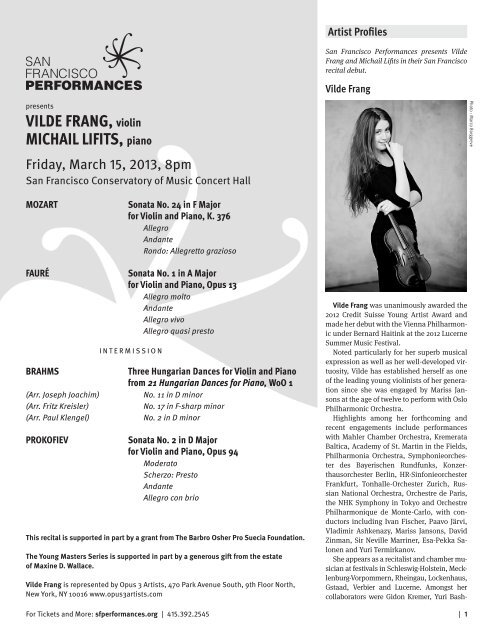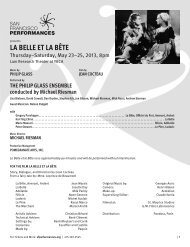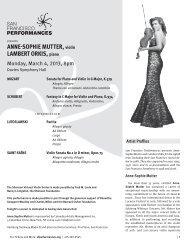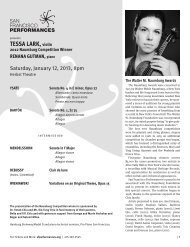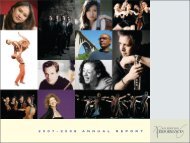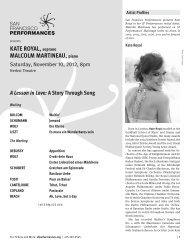VILDE FRANG, violin MICHAIL LIFITS, piano - San Francisco ...
VILDE FRANG, violin MICHAIL LIFITS, piano - San Francisco ...
VILDE FRANG, violin MICHAIL LIFITS, piano - San Francisco ...
Create successful ePaper yourself
Turn your PDF publications into a flip-book with our unique Google optimized e-Paper software.
presents<br />
<strong>VILDE</strong> <strong>FRANG</strong>, <strong>violin</strong><br />
<strong>MICHAIL</strong> <strong>LIFITS</strong>, <strong>piano</strong><br />
Friday, March 15, 2013, 8pm<br />
<strong>San</strong> <strong>Francisco</strong> Conservatory of Music Concert Hall<br />
MOZART Sonata No. 24 in F Major<br />
for Violin and Piano, K. 376<br />
Allegro<br />
Andante<br />
Rondo: Allegretto grazioso<br />
FAURÉ Sonata No. 1 in A Major<br />
for Violin and Piano, Opus 13<br />
Allegro molto<br />
Andante<br />
Allegro vivo<br />
Allegro quasi presto<br />
INTERMISSION<br />
BRAHMS Three Hungarian Dances for Violin and Piano<br />
from 21 Hungarian Dances for Piano, WoO 1<br />
(Arr. Joseph Joachim) No. 11 in D minor<br />
(Arr. Fritz Kreisler) No. 17 in F-sharp minor<br />
(Arr. Paul Klengel) No. 2 in D minor<br />
PROKOFIEV Sonata No. 2 in D Major<br />
for Violin and Piano, Opus 94<br />
Moderato<br />
Scherzo: Presto<br />
Andante<br />
Allegro con brio<br />
This recital is supported in part by a grant from The Barbro Osher Pro Suecia Foundation.<br />
The Young Masters Series is supported in part by a generous gift from the estate<br />
of Maxine D. Wallace.<br />
Vilde Frang is represented by Opus 3 Artists, 470 Park Avenue South, 9th Floor North,<br />
New York, NY 10016 www.opus3artists.com<br />
Artist Profiles<br />
<strong>San</strong> <strong>Francisco</strong> Performances presents Vilde<br />
Frang and Michail Lifits in their <strong>San</strong> <strong>Francisco</strong><br />
recital debut.<br />
Vilde Frang<br />
Vilde Frang was unanimously awarded the<br />
2012 Credit Suisse Young Artist Award and<br />
made her debut with the Vienna Philharmonic<br />
under Bernard Haitink at the 2012 Lucerne<br />
Summer Music Festival.<br />
Noted particularly for her superb musical<br />
expression as well as her well-developed virtuosity,<br />
Vilde has established herself as one<br />
of the leading young <strong>violin</strong>ists of her generation<br />
since she was engaged by Mariss Jansons<br />
at the age of twelve to perform with Oslo<br />
Philharmonic Orchestra.<br />
Highlights among her forthcoming and<br />
recent engagements include performances<br />
with Mahler Chamber Orchestra, Kremerata<br />
Baltica, Academy of St. Martin in the Fields,<br />
Philharmonia Orchestra, Symphonieorchester<br />
des Bayerischen Rundfunks, Konzerthausorchester<br />
Berlin, HR-Sinfonieorchester<br />
Frankfurt, Tonhalle-Orchester Zurich, Russian<br />
National Orchestra, Orchestre de Paris,<br />
the NHK Symphony in Tokyo and Orchestre<br />
Philharmonique de Monte-Carlo, with conductors<br />
including Ivan Fischer, Paavo Järvi,<br />
Vladimir Ashkenazy, Mariss Jansons, David<br />
Zinman, Sir Neville Marriner, Esa-Pekka Salonen<br />
and Yuri Termirkanov.<br />
She appears as a recitalist and chamber musician<br />
at festivals in Schleswig-Holstein, Mecklenburg-Vorpommern,<br />
Rheingau, Lockenhaus,<br />
Gstaad, Verbier and Lucerne. Amongst her<br />
collaborators were Gidon Kremer, Yuri Bash-<br />
For Tickets and More: sfperformances.org | 415.392.2545 | 1<br />
Photo : Marco Borggreve
Photo : Felix Broede<br />
met, Martha Argerich, Julian Rachlin, Leif Ove<br />
Andsnes, Sol Gabetta and Maxim Vengerov,<br />
and together with Anne-Sophie Mutter she has<br />
toured in Europe and the US, playing Bach’s<br />
Double Concerto with Camerata Salzburg.<br />
After her 2007 debut with London Philharmonic<br />
Orchestra, Vilde was re-engaged for a<br />
concert with the orchestra and Vladimir Jurowski<br />
at the Royal Festival Hall in the 2009<br />
season, followed by a recital at Wigmore<br />
Hall. Her concerto recording debut as EMI<br />
Classics’ Young Artist of the Year 2010 was<br />
greeted with acclaim by critics throughout<br />
the world and received the Edison Klassiek<br />
Award and a Classic BRIT Award for Best<br />
Newcomer. Her second disc, a recital recording<br />
with her duo partner Michail Lifits,<br />
received a Gramophone Award Nomination,<br />
Diapason Magazine’s “Diapason d‘Or” and<br />
the Echo Klassik Award. Her most recent release,<br />
featuring concertos by Tchaikovsky<br />
and Carl Nielsen, received the Deutsche<br />
Schallplattenpreis and was named Editor’s<br />
Choice by Gramophone Magazine.<br />
Born in 1986 in Norway, Vilde has studied<br />
at the Barratt Due Musikkinstitutt in Oslo,<br />
with Kolja Blacher at Musikhochschule Hamburg<br />
and Ana Chumachenco at the Kronberg<br />
Academy. She plays a Jean-Baptiste Vuillaume<br />
<strong>violin</strong> lent by the Anne-Sophie Mutter<br />
Freundeskreis Stiftung.<br />
Michail Lifits<br />
Michail Lifits, already compared to the legendary<br />
Wilhelm Kempff and praised for “his<br />
inspirational tone and his wise maturity”, as<br />
well as for “the breathtaking beauty of his<br />
playing”, has increasingly captured public<br />
attention since his debut at the age of 13 with<br />
Rachmaninov’s Second Piano Concerto.<br />
Winner of the 57th Ferruccio Busoni International<br />
Piano Competition in Bolzano (2009),<br />
he had already collected first prizes in other international<br />
competitions in Italy and the USA,<br />
such as Pianello val Tidone (2003), Treviso<br />
(2004), Monza (2006) and Hilton Head (2009).<br />
Solo engagements have brought Michail<br />
Lifits to Carnegie Hall’s Weill Recital Hall<br />
and Lincoln Center in New York, the Auditorium<br />
du Louvre in Paris, to the Teatro della<br />
Pergola in Florence, the NCPA in Beijing,<br />
the Tonhalle in Zurich and the Sala Verdi in<br />
Milan. He is a regular guest at international<br />
festivals in France, Germany, Poland, Italy<br />
and the United States, including the Festival<br />
d’Auvers-sur-Oise, the Annecy Festival, the<br />
Kissinger Sommer, Rheingau Music Festival,<br />
the Ruhr Piano Festival, Festspiele Mecklenburg-Vorpommern<br />
and the Chopin Festival in<br />
Duzhniki Zdroj. Among his appearances with<br />
Orchestra he has played with the Hilton Head<br />
Symphony, the Thüringen Philharmonie<br />
Gotha, the Orchestra del Teatro Verdi di Trieste<br />
and the Orchestra Sinfonica Siciliana in<br />
Palermo. In 2011 he made his debut with the<br />
Deutsche Symphonie-Orchester Berlin (DSO).<br />
The same year saw his debut in London’s<br />
Wigmore Hall, in the `Keyboard Trust Prizewinners<br />
Series’ which exhibits the cream of this international<br />
foundation’s new talent. Critics described<br />
his performance as “Perfection itself.”<br />
Since 2011, Michail Lifits has been under contract<br />
with the classical label DECCA/Universal<br />
Classics. In 2012 DECCA released his debut CD<br />
dedicated to Wolfgang Amadeus Mozart.<br />
Michail Lifits was born in 1982 in Tashkent,<br />
Uzbekistan. He studied with Karl-Heinz Kammerling<br />
and Bernd Goetzke at the University<br />
for Music and Drama in Hanover and with<br />
Boris Petrushansky at the International Piano<br />
Academy Incontri col Maestro in Imola (Italy).<br />
Program Notes<br />
Sonata No. 24 in F Major<br />
for Violin and Piano, K. 376<br />
Wolfgang Amadeus Mozart<br />
Born January 27, 1756, Salzburg<br />
Died December 5, 1791, Vienna<br />
In June 1781, at the age of 25, Mozart broke<br />
away from the two authority figures in his<br />
life—his father and Archbishop Colloredo of<br />
Salzburg—and set out to establish himself in<br />
Vienna. His first task was to make himself<br />
financially independent, and to that end he<br />
took students and performed widely in Vienna.<br />
But Mozart wished to succeed as a composer,<br />
and the sources of income for a composer<br />
were more complex. A composer could<br />
make significant income from an opera commission,<br />
but Mozart was also aware of a quite<br />
different market: the increasing number of<br />
amateur musicians in Vienna who needed<br />
music to perform. His first publication in Vienna<br />
was written not on commission from a<br />
member of the nobility but for talented amateur<br />
performers: during the summer of 1781,<br />
while he was at work on The Abduction from<br />
the Seraglio, Mozart wrote four sonatas for<br />
keyboard and <strong>violin</strong>, combined them with<br />
two sonatas written earlier, and published<br />
the set that November as his Opus 2.<br />
These six sonatas attracted immediate attention,<br />
and one early reviewer wrote about<br />
them at length: “These sonatas are the only<br />
ones of this kind. Rich in new ideas and in<br />
evidences of the great musical genius of their<br />
author. Very brilliant and suited to the instrument.<br />
At the same time the accompaniment<br />
of the <strong>violin</strong> is so artfully combined with the<br />
clavier part that both instruments are kept<br />
constantly on the alert; so that these sonatas<br />
require just as skillful a player on the <strong>violin</strong><br />
as on the clavier.” This reviewer makes at an<br />
important point. Earlier sonatas for this combination<br />
of instruments had essentially been<br />
keyboard sonatas with the accompaniment<br />
of <strong>violin</strong>, and in fact Mozart’s description<br />
on the title page of the new set seems to preserve<br />
that identity: “Six Sonatas for Clavier<br />
or Pianoforte, with the Accompaniment of<br />
a Violin.” The reviewer, however, notes that<br />
these are in fact duo-sonatas (“the only ones<br />
of this kind”) and that the musical duties are<br />
divided evenly here (“require just as skillful<br />
a player on the <strong>violin</strong> as on the clavier”). The<br />
<strong>piano</strong> may retain a measure of primacy in<br />
these sonatas, but Mozart is well on his ways<br />
to re-defining the <strong>violin</strong> sonata and giving<br />
the <strong>violin</strong> a much more important role.<br />
The Allegro opens with three bright chords,<br />
and the whole movement is characterized by<br />
energy and thrust. The <strong>piano</strong> introduces the<br />
more restrained second idea, and all seems<br />
set for a standard sonata-form movement,<br />
but Mozart springs a surprise at the development.<br />
Rather than developing these themes,<br />
he instead seizes on a brief turn-figure from<br />
the end of the exposition and builds the development<br />
on this. He brings back his principal<br />
themes in the recapitulation and closes<br />
the movement out quietly on the turn-figure.<br />
The Andante is remarkable for the range of<br />
its sounds, for it seems in constant, murmuring<br />
motion. Some of this is the sound of<br />
quietly-pulsing sixteenths that runs through<br />
the accompaniment, but Mozart also has<br />
both instruments trilling at length here. The<br />
concluding Rondo gets off to an elegant start<br />
(Mozart’s marking grazioso is exactly right),<br />
but this attractive tune is interrupted by a<br />
number of varied and substantial episodes<br />
2 | For Tickets and More: sfperformances.org | 415.392.2545
efore the movement makes its way to the<br />
nicely-understated close.<br />
Violin Sonata in A Major, Opus 13<br />
Gabriel Fauré<br />
Born May 13, 1845, Pamiers<br />
Died November 4, 1924, Paris<br />
One of Fauré’s students, the composer Florent<br />
Schmitt, described his teacher as an “unintentional,<br />
unwitting revolutionary.” The<br />
term “revolutionary” hardly seems to apply<br />
to a composer best-known for his gentle Requiem,<br />
songs, and chamber works. But while<br />
Fauré was no heaven-storming radical bent<br />
on undoing the past, his seemingly-quiet<br />
music reveals enough rhythmic, harmonic,<br />
and melodic surprises to justify Schmitt’s<br />
claim. The Violin Sonata in A Major, written<br />
in the summer of 1876 while Fauré was vacationing<br />
in Normandy, is dedicated to his<br />
friend, the <strong>violin</strong>ist Paul Viardot. Following<br />
its first performance, the sonata was praised<br />
by Fauré’s teacher Saint-Saëns for its “formal<br />
novelty, quest, refinement of modulation, curious<br />
sonorities, use of the most unexpected<br />
rhythms…charm [and]…the most unexpected<br />
touches of boldness.” This is strong praise,<br />
but close examination of the sonata shows<br />
that Saint-Saëns was right.<br />
One of the most interesting features of the<br />
opening Allegro molto occurs in the accompaniment,<br />
which is awash in a constant flow of<br />
eighth-notes. The first theme appears immediately<br />
in the <strong>piano</strong>, and already that instrument<br />
is weaving the filigree of accompanying<br />
eighth-notes that will shimmer throughout<br />
this movement: one of the challenges for performers<br />
is to provide tonal variety within this<br />
continual rustle of sound. The movement is<br />
in sonata form, and the descending second<br />
theme, introduced by the <strong>violin</strong>, is accompanied<br />
by a murmur of triplets from the <strong>piano</strong>.<br />
The movement concludes on a fiery restatement<br />
of the opening theme.<br />
Distinguishing the Andante is its rhythmic<br />
pulse: a 9/8 meter throbs throughout the<br />
movement, though Fauré varies its effect by<br />
syncopating the accents within the measure.<br />
The third movement, a scherzo marked Allegro<br />
vivo, goes like a rocket. Fauré chooses<br />
not the expected triple meter of the traditional<br />
scherzo but a time signature of 2/8, an<br />
extremely short rhythmic unit, particularly<br />
when his metronome marking asks for 152<br />
quarter-notes per minute. He further complicates<br />
the rhythm by writing in quite short<br />
phrases, so that the effect is of short phrases<br />
rapidly spit out, then syncopated by sharp<br />
off-beats. A lovely, graceful trio gives way to<br />
the opening material, and the movement suddenly<br />
vanishes in a shower of pizzicato notes.<br />
The tempo marking for the finale—Allegro<br />
quasi presto—seems to suggest a movement<br />
similar to the third, but despite its rapid tempo<br />
the last movement flows easily and majestically.<br />
Or at least it seems to, for here Fauré<br />
complicates matters harmonically. The <strong>piano</strong><br />
opens in the home key—A major—but the<br />
<strong>violin</strong> seems always to prefer that key’s relative<br />
minor, F-sharp minor, and the resulting<br />
harmonic uncertainty continues throughout<br />
the movement until the sonata ends in unequivocal<br />
A major.<br />
To emphasize this sonata’s originality may<br />
have the unhappy effect of making the music<br />
sound cerebral, interesting only for its technical<br />
novelty. That is hardly the case. Fauré’s<br />
Sonata in A Major is one of the loveliest <strong>violin</strong><br />
sonatas of the late nineteenth century, full of<br />
melodic, graceful, and haunting music.<br />
Hungarian Dances<br />
No. 2 in D minor<br />
No. 11 in D minor<br />
No. 17 in F-sharp minor<br />
Johannes Brahms<br />
Born May 7, 1833, Hamburg<br />
Died April 3, 1897, Vienna<br />
Brahms had a life-long fascination with<br />
Hungarian music, which for him meant<br />
gypsy music. As a boy in Hamburg, he first<br />
encountered it from the refugees fleeing revolutions<br />
in Hungary for a new life in America,<br />
and he was introduced to gypsy fiddle tunes<br />
at the age of 20 while on tour with the Hungarian<br />
<strong>violin</strong>ist Eduard Reményi (it was on<br />
that tour that Brahms began his lifelong<br />
collection of Hungarian folk-tunes). Over a<br />
period of years, he wrote a number of what<br />
he called Hungarian Dances for <strong>piano</strong> fourhands<br />
and played them for (and with) his<br />
friends. He published ten of these in 1869<br />
and another eleven in 1880, and they proved<br />
a huge success. There was a ready market<br />
for this sort of music that could be played at<br />
home by talented amateurs, and these fiery,<br />
fun pieces carried Brahms’ name around the<br />
world (they also inspired the Slavonic Dances<br />
of his friend Antonín Dvořák)<br />
In the Hungarian Dances, Brahms took<br />
csardas tunes and–preserving their themes<br />
and characteristic freedom–wrote his own<br />
music based on them. To his publisher,<br />
Brahms described these dances as “genuine<br />
gypsy children, which I did not beget, but<br />
merely brought up with bread and milk.” It<br />
has been pointed out, however, that Brahms<br />
did not begin with authentic peasant tunes<br />
(which Bartók and Kodály would track down<br />
in the twentieth century), but with those<br />
tunes as they had been spiffed-up for popular<br />
consumption by the “gypsy” bands that<br />
played in the cafés and on the streetcorners<br />
of Vienna. Brahms would not have cared<br />
about authenticity. He loved these tunes–<br />
with their fiery melodies, quick shifts of<br />
mood, and rhythmic freedom–and he successfully<br />
assimilated that style, particularly<br />
its atmosphere of wild gypsy fiddling (in fact,<br />
he assimilated it so successfully that several<br />
of the Hungarian Dances are based on “gypsy”<br />
tunes that he composed himself).<br />
This concert offers three of Brahms’ Hungarian<br />
Dances. Program notes for the individual<br />
dances would be a form of intellectual<br />
overkill. Sit back, enjoy this fiery music, and<br />
sense why Brahms loved it as much as he did.<br />
Sonata No. 2 in D Major<br />
for Violin and Piano, Opus 94<br />
Serge Prokofiev<br />
Born April 23, 1891, Sontsovka<br />
Died March 5, 1953, Moscow<br />
This sonata, probably the most popular<br />
<strong>violin</strong> sonata composed in the twentieth century,<br />
was originally written for the flute. But<br />
when David Oistrakh heard the premiere on<br />
December 7, 1943, he immediately suggested<br />
to the composer that it was ideal music for<br />
the <strong>violin</strong>. Together, composer and <strong>violin</strong>ist<br />
prepared a version for <strong>violin</strong> and <strong>piano</strong>,<br />
and Oistrakh gave the first performance of<br />
this version on June 17, 1944. The music remains<br />
very much the same (the <strong>piano</strong> part is<br />
identical in both versions), but Prokofiev altered<br />
several passages to eliminate awkward<br />
string crossings for the <strong>violin</strong>ist and added<br />
certain <strong>violin</strong>istic features impossible on the<br />
flute: pizzicatos, doublestops, harmonics.<br />
Ironically, the <strong>violin</strong> version–which profits<br />
enormously from the flexibility and range of<br />
sound of the <strong>violin</strong>–has become much more<br />
popular than the original.<br />
In contrast to the bleak First Violin Sonata<br />
(which the composer said should sound “like<br />
wind in a graveyard”), the Second Sonata is<br />
one of Prokofiev’s sunniest compositions.<br />
There is no hint in this music of the war raging<br />
in Russia at this time, none of the pain<br />
that runs through the earlier sonata. The<br />
third movement is quietly wistful and the<br />
music is full of Prokofiev’s characteristically<br />
pungent harmonies, but the sonata is generally<br />
serene, a retreat from the war rather than<br />
its mirror.<br />
continued on page 4<br />
For Tickets and More: sfperformances.org | 415.392.2545 | 3
Frang Notes continued from page 3<br />
The sonata is in the four-movement slowfast-slow-fast<br />
sequence of the baroque sonata.<br />
The opening Moderato, in sonata form,<br />
begins with a beautifully poised melody for<br />
the <strong>violin</strong>, a theme of classical purity. The<br />
<strong>violin</strong> also has the second subject, a singing<br />
dotted melody. Prokofiev calls for an exposition<br />
repeat, and the vigorous development<br />
leads to a quiet close on a very high restatement<br />
of the opening idea.<br />
The Presto sounds so brilliant and idiomatic<br />
on the <strong>violin</strong> that it is hard to imagine<br />
that it was not conceived originally for that in-<br />
strument. This movement was in fact marked<br />
Allegretto scherzando in the flute version,<br />
but—taking advantage of the <strong>violin</strong>’s greater<br />
maneuverability—Prokofiev increased the<br />
tempo to Presto in the <strong>violin</strong> version, making<br />
it a much more brilliant movement. It falls<br />
into the classical scherzo-and-trio pattern,<br />
with two blazing themes in the scherzo and<br />
a wistful melody in the trio. The end of this<br />
movement, with the <strong>violin</strong> driving toward the<br />
climactic pizzicato chord, is much more effective<br />
in the <strong>violin</strong> version than in the original.<br />
The mood changes markedly at the Andante,<br />
which is a continuous flow of melody<br />
on the opening <strong>violin</strong> theme. The <strong>violin</strong> part<br />
becomes more elaborate as the movement<br />
progresses, but the quiet close returns to the<br />
mood of the beginning. The Allegro con brio<br />
finale is full of snap and drive, with the <strong>violin</strong><br />
leaping throughout its range. At the center<br />
of this movement, over steady <strong>piano</strong> accompaniment,<br />
Prokofiev gives the <strong>violin</strong> one of<br />
those bittersweet melodies so characteristic<br />
of his best music. Gradually the music quickens,<br />
returns to the opening tempo, and the<br />
sonata flies to its resounding close.<br />
—Program notes by Eric Bromberger<br />
4 | For Tickets and More: sfperformances.org | 415.392.2545


